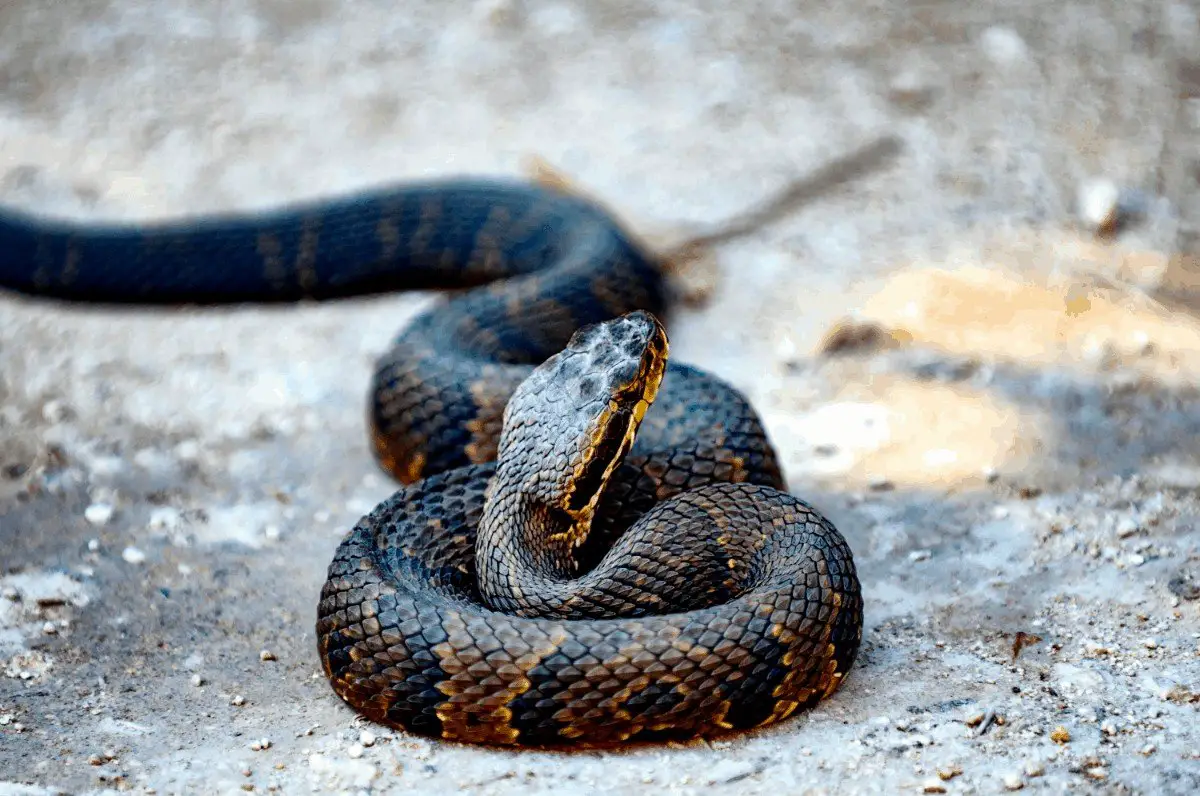Last Updated on July 19, 2022 by Ecorf
Do you know that there are specific types of snakes that can swim and love to live near water bodies? While other snakes are harmless, water moccasin also called cottonmouth is a poisonous and aggressive snake that you can find near water bodies. All the same, whether venomous or not, you need to be cautious and avoid getting too close to any snake.
If you love activities like fishing, boating or hiking, you must be careful just in case you can come across this type of snake. If you want to understand how to identify water moccasin, there are certain features and characteristics exhibited by this kind of snake that you should look for. This guide gives you some details about the features of a water moccasin snake that you should look for.
Table of Contents
Why You Should Be Able to Identify Water Moccasin?
Water moccasin has hemotoxic venom which affects red blood cells and disrupts the anti-blood-clotting process. The victim’s blood pressure lowers following a snake bite from a viper that has hemotoxic venom and this affects blood clotting. The bite is usually very painful and can lead to permanent tissue damage or even death.
Water moccasins are poisonous but one notable aspect about these snakes is that they are not that aggressive like venomous snakes that are found in different parts of the globe such as Africa as well as India. In most cases, water moccasins only attack when they feel threatened but they prefer to avoid people. On the other hand, other water snakes can also bite but they are not poisonous.
Therefore, identifying water moccasins helps you to know their behavior, habitats, identifying features as well as diet among other factors. This will help you to be on the safe side in case you encounter this snake while you are on your expedition. The following are factors that you should consider to identify a water moccasin.
Body of the Water Moccasin
A water moccasin has a thick body that resembles that of a python and it also has a narrow neck. The snack also has a tapered thin tail. The water moccasin snake is always fat and it appears as if it has eaten something. On the other hand, a harmless water snake has a slender body but its neck is almost the same size as its body and head.
The neck of water moccasin is thin and it is narrower than its body that is thick. The neck is also smaller than the head which helps you to identify a water moccasin. To avoid confusing water snake and water moccasin, you just need to check on their bodies. The water moccasin is thick while the harmless water snake is slim. You can tell from afar the difference between the two since it is outstanding.
Head and Eyes of Water Moccasin
Water moccasin has a large block-like head which also has a triangular shape. It also has catlike eyes with vertical corneas. Between the eyes and the nostrils of the snake, there are visible pits that also act as heat sensors which make it belong to the viper pit family. The heat sensors help the viper to hunt down its prey.
The interior of the water moccasin’s mouth is white like cotton which earned it another common name; “cottonmouth.’ The snake opens its cottonmouth wide to scare humans away in case it is threatened. It also vibrates its tail while coiling on one position to scare you away or readying to attack. It does not immediately attack unless it feels threatened.
When the water moccasin’s mouth is wide open, it also produces a hissing sound. When the snake feels threatened, it can strike but it does not have the most toxic venom in the US. Out of about 7,000 to 8,000 snake bites per year, about five fatalities only are recorded.
Color Variations of Water Moccasin
Juvenile water moccasins have bright colors consisting of red-brown bands that extend across their backs down the sides without crossing the belly. As the snake ages, its cross bands develop dark spots and flecks on its back. The patterns will darken as well but the adults will retain their original banding.
Water moccasins usually do not appear shiny due to their keeled scales but they instead appear dull when they are within surfaces that are non-reflective. The tail of the snake becomes black as it ages and this might make it difficult to see the bands on its body.
Behavior of Cottonmouth Snake
Water moccasins prefer to live near freshwater habitats since these are also sources of their food. However, they can live without water though their common habitats include marshes, river floodplains, overgrown ponds, and swamps. Cottonmouths can also travel to inland areas that are far from water bodies.
When swimming in the water, a cottonmouth can be difficult to spot since its heavy and thick body is always submerged in water. However, its head is always out of the water when the snake is swimming. When you spot a moving head in water, be careful, you will be looking at a cottonmouth.
Conclusion
A water moccasin or cottonmouth is one of the most dangerous snakes on earth but it is not that aggressive against humans. Besides that, you need to be able to identify this kind of snake to be safe when you are hiking, camping or performing other outdoor activities like boating. You can consider elements like color, body as well as other traits that define its behavior.
For instance, it has olive, dark tan or brown color which also appears almost like black body. A cottonmouth snack has a narrow neck, thick body which tapers to a long and thin tail. It also has a triangular head, white mouth, and it opens it widely before striking. The cottonmouths have bands over their bodies which darken over time as they age. They also have a unique way of swimming where they keep the head out of water.



